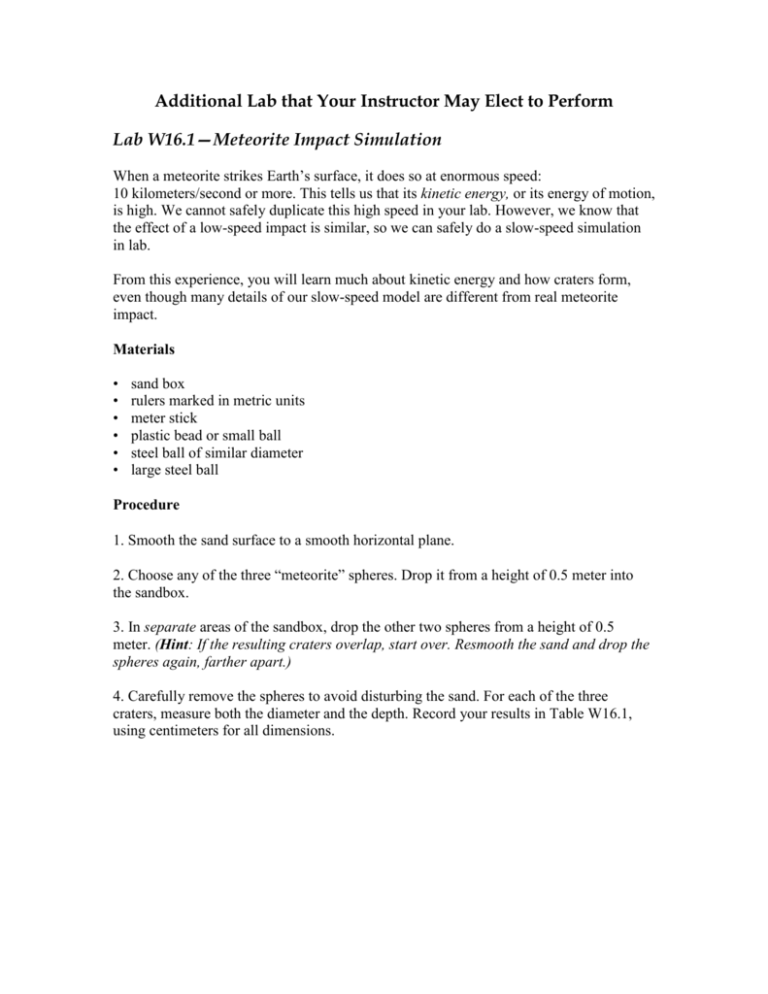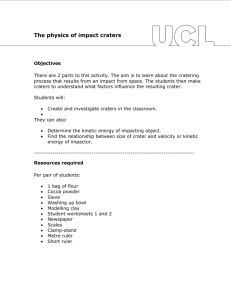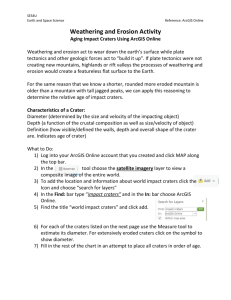Practice_Prob_unit16
advertisement

Additional Lab that Your Instructor May Elect to Perform Lab W16.1—Meteorite Impact Simulation When a meteorite strikes Earth’s surface, it does so at enormous speed: 10 kilometers/second or more. This tells us that its kinetic energy, or its energy of motion, is high. We cannot safely duplicate this high speed in your lab. However, we know that the effect of a low-speed impact is similar, so we can safely do a slow-speed simulation in lab. From this experience, you will learn much about kinetic energy and how craters form, even though many details of our slow-speed model are different from real meteorite impact. Materials • • • • • • sand box rulers marked in metric units meter stick plastic bead or small ball steel ball of similar diameter large steel ball Procedure 1. Smooth the sand surface to a smooth horizontal plane. 2. Choose any of the three “meteorite” spheres. Drop it from a height of 0.5 meter into the sandbox. 3. In separate areas of the sandbox, drop the other two spheres from a height of 0.5 meter. (Hint: If the resulting craters overlap, start over. Resmooth the sand and drop the spheres again, farther apart.) 4. Carefully remove the spheres to avoid disturbing the sand. For each of the three craters, measure both the diameter and the depth. Record your results in Table W16.1, using centimeters for all dimensions. Table W16.1 Your crater and “meteorite” data. “Meteorite” Plastic bead or ball Similar-size steel ball Larger steel ball 0.5-meter drop Crater Crater diameter depth (cm) (cm) 1-meter drop Crater Crater diameter depth (cm) (cm) Mass (weight) (grams) Diameter (mm) Density of meteorite 5. Repeat the preceding steps, but this time drop each sphere from a height of 1 meter. Record your results in the table. 6. Weigh each sphere in grams. Record your results in the table. 7. Using the millimeter scale on your ruler, carefully measure the diameter of the three spheres. Record your results in the table. WQ16.1. Figure WS16.1 is a grid for graphing your results. Mark the X-axis so you can show your crater diameter measurements. Mark the Y-axis so you can show your “meteorite” diameters. Plot the values for the spheres you dropped. (Hint: Use a regular black pencil to show results for the 0.5-meter drops and a colored pencil to show results for the 1-meter drops.) Figure WS16.1 Crater diameter versus sphere diameter. WQ16.2. In Figure WS16.2, construct a similar graph. Use the same X-axis as in Figure WS16.1, but make the Y-axis the spheres’ weights (mass, in grams). Figure WS16.2 Crater diameter versus sphere mass. WQ16.3. At Earth’s surface, the velocity of objects dropped from a height of 0.5 meter is about 300 centimeters/second. The velocity of objects dropped from a height of 1 meter is about 450 cm/sec. Using this information, plot the crater diameters you measured against projectile velocity on Figure WS16.3. Figure WS16.3 Crater diameter versus sphere velocity. WQ16.4. Which of the variables you graphed appear to be most clearly linked to the diameters of the craters produced? 8. Calculate the volume of the craters you produced in the sand. Use this formula: Volume of crater (0.3) (d/2)2 D where: 3.14 d = diameter of crater (in centimeters) D = vertical depth of crater (in centimeters) means “approximately equals” WQ16.5. Record your calculations in Table W16.1. 9. Kinetic energy (the energy of motion) reflects both the velocity (speed) of a moving object and its mass (which, for our purposes, equals its weight). The equation that defines kinetic energy is: E = 0.5 mv2 where: E = energy (kinetic) in ergs m = mass (weight) in grams v = velocity in cm/sec 10. The velocity of an object dropped on Earth surface from a height of 0.5 meter is about 300 centimeters/second and from 1 meter is about 450 centimeters/second. Calculate the kinetic energy of impact for each of your observations. Complete the appropriate cells in Table W16.1. WQ16.6. Plot your results in Figure WS16.4. Use crater volume for the X-axis and kinetic energy for the Y-axis. (Hint: Use regular black pencil for the 0.5-meter case and a colored pencil for the 1-meter case.) Figure WS16.4 Crater volume versus kinetic energy. Applying What You Just Experienced Some relationships in the natural world are logarithmic or based on exponential functions. From the shape of your results on Figure WS16.3, you may suspect that you are dealing with such a relationship in the case of cratering. Using a calculator, take the log of each of your kinetic energy values in Table W16.1. Record your answers here: Plastic bead or ball: __________________________ Similar-size steel ball: ________________________ Larger steel ball: _____________________________ WQ16.7. Plot your values on Figure WS16.5. Figure WS16.5 Crater volume versus log kinetic energy. WQ16.8. Examine your crater volume versus log kinetic energy on Figure WS16.4. Have you demonstrated a direct relationship between crater volume and the log of kinetic energy? WQ16.9. You doubtless have seen many craters in pictures of the moon. The volume of a few lunar craters is great, implying that an enormous level of kinetic energy was released by the impact. Name and explain the major process that must have helped dissipate this staggering amount of kinetic energy. WQ16.10. From what you have learned in lecture and from your textbook, in what ways does the experiment you have done not model the process of meteorite impact on a planet or the moon?







